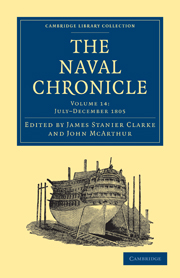 The Naval Chronicle
The Naval Chronicle Book contents
- Frontmatter
- PREFACE
- PLATES IN VOLUME XIV
- BIOGRAPHICAL MEMOIR OF SIR THOMAS BOULDEN THOMPSON, KNT. OF THE ROYAL NAVY
- BIOGRAPHICAL MEMOIR OF THE LATE HONOURABLE CAPTAIN RICHARD WALPOLE, COMMANDER OF THE HOUGHTON EAST INDIAMAN
- BIOGRAPHICAL MEMOIR OF JOHN BAZELY, ESQ. VICE-ADMIRAL OF THE RED SQUADRON
- BIOGRAPHICAL MEMOIR OF MAURICE SUCKLING, ESQ.
- BIOGRAPHICAL MEMOIR OF PHILLIPS COSBY, Esq.
- BIOGRAPHICAL MEMOIR OF THE LATE SIR FREDERICK THESIGER, KNIGHT OF THE RUSSIAN ORDER OF ST. GEORGE, AND CAPTAIN IN THE ROYAL NAVY
- INDEX
BIOGRAPHICAL MEMOIR OF PHILLIPS COSBY, Esq.
Published online by Cambridge University Press: 10 January 2011
- Frontmatter
- PREFACE
- PLATES IN VOLUME XIV
- BIOGRAPHICAL MEMOIR OF SIR THOMAS BOULDEN THOMPSON, KNT. OF THE ROYAL NAVY
- BIOGRAPHICAL MEMOIR OF THE LATE HONOURABLE CAPTAIN RICHARD WALPOLE, COMMANDER OF THE HOUGHTON EAST INDIAMAN
- BIOGRAPHICAL MEMOIR OF JOHN BAZELY, ESQ. VICE-ADMIRAL OF THE RED SQUADRON
- BIOGRAPHICAL MEMOIR OF MAURICE SUCKLING, ESQ.
- BIOGRAPHICAL MEMOIR OF PHILLIPS COSBY, Esq.
- BIOGRAPHICAL MEMOIR OF THE LATE SIR FREDERICK THESIGER, KNIGHT OF THE RUSSIAN ORDER OF ST. GEORGE, AND CAPTAIN IN THE ROYAL NAVY
- INDEX
Summary
“WHAT FORM OF DEATH COULD HIM AFFRIGHT,
WHO, UNCONCERN'D, WITH STEDFAST SIGHT
COULD VIEW THE SURGES, MOUNTAIN-STEEP,
AND MONSTERS ROLLING IN THE DEEP?”
DRYDEN.IN tracing the progress of Gentlemen, whose professional exertions entitle them to an inscription on the columna rostrata of their Country, we have often to regret our inability to ascertain the period of their entering the Service. Our knowledge sometimes only commences at the time of their attaining the rank of Post Captain. Yet, to say nothing of that humble state of probation, as it may be termed, in which the aspiring Mid inhales the fumes of the orlop, the services of a Lieutenant are generally useful, frequently conspicuous, and sometimes splendid. The Master and Commander has also a superior chance of displaying his abilities. Our regret on this subject, however, does not extend to the present respected object of our notice; as we have the pleasure of being able to present an outline of Admiral Cosby's naval career, from its commencement down to the present time.
Phillips Cosby, of Stradbally Hall, Queen's County, Ireland, Esq., is the representative of an Irish family of some distinction. In the beginning of the year 1745, at an early period of life, he went into the Navy, on board of the Comet Bomb, commanded by the late Admiral Sir Richard Spry, as Captain. On the 12th of February, in the same year, almost immediately after he had become a worshipper at the shiine of Neptune, he was in a severe engagement with a Spanish Ship of War, called the Galga, of 36 guns.
- Type
- Chapter
- Information
- The Naval ChronicleContaining a General and Biographical History of the Royal Navy of the United Kingdom with a Variety of Original Papers on Nautical Subjects, pp. 353 - 440Publisher: Cambridge University PressPrint publication year: 2010First published in: 1805
